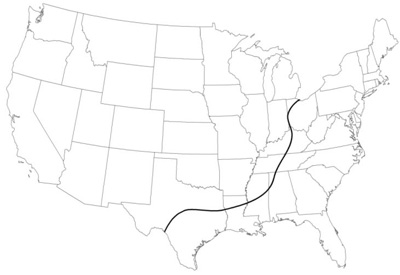Dr Vino's wine blog
wine talk that goes down easy
Calculating the carbon footprint of wine: my research findings
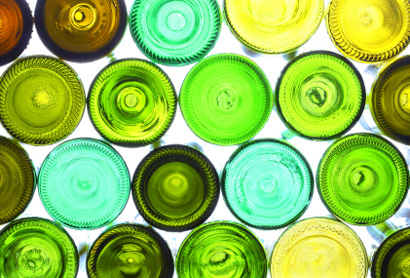
Is that a whiff of raspberries and leather you get from that red wine–or a whiff of petroleum? With some premium wines consuming three times their weight in petroleum, don’t be surprised if it is the latter.
My previous postings on the carbon footprint of wine made me want to determine just how much carbon is involved in the making and transporting of our favorite beverage. So I collaborated with Pablo Paster, a sustainability metrics specialist, and we ran the numbers. Our findings have just been published as a working paper for the American Association of Wine Economists, available here as a pdf.
While I welcome your comments on the whole paper, I’ll post some of the key findings here:
* Organic farming has lower greenhouse gas (GHG) intensity than conventional farming but I was surprised that the difference wasn’t greater. Clearly there may be other differences in a local ecosystem but the GHG difference was surprisingly small. But on the whole, it was the transportation that played a more significant role from a GHG perspective.
* Regarding the “food miles” debate, we find that distance does matter.
* But not all miles that a bottle travels are the same. Efficiencies in transportation make container ships better than trucks, which in turn are better than planes.
* Shipping premium wine, bottled at the winery, around the world mostly involves shipping glass with some wine in it. In this regard, drinking wine from a magnum is the more carbon-friendly choice since the glass-to-wine ratio is less. Half-bottles, by contrast, worsen the ratio.
* Shipping wine in bulk from the source and bottling closer to the point of consumption lowers carbon intensity.
* Light packaging material such as Tetra-Pak or bag-in-a-box has much less carbon intensity.
* Using oak chips is a more carbon friendly alternative than oak barrels, particularly those that are shipped assembled and empty around the world
* There’s a “green line” that runs down the middle of Ohio. For points to the West of that line, it is more carbon efficient to consume wine trucked from California. To the East of that line, it’s more efficient to consume the same sized bottle of wine from Bordeaux, which has had benefited from the efficiencies of container shipping, followed by a shorter truck trip. In the event that a carbon tax were ever imposed, it would thus have a decidedly un-nationalistic impact.
What does this mean for the green wine consumer? Drinking a wine made without agrichemicals, from larger format bottles, or wine that has traveled fewer miles is the more “green” option. Beyond these points (or in addition to them), you could perform your own carbon offsets, for example, by giving up one bottle for another and saying no to bottled water.
“Red, White and “Green”: The Cost of Carbon In the Global Wine Trade,” By Tyler Colman and Pablo Paster
UODATE: This paper was been published in the March 2009 issue of the Journal of Wine Research
image 1: istockphoto.com
Exchange this! NZ horticulturalist is fired up about carbon
 Craig Foss is madder than hell. And who has caught the ire of this New Zealander? The Times of London, for running a table suggesting that British wine consumers could switch from New Zealand wines to French wine to reduce their carbon footprint.
Craig Foss is madder than hell. And who has caught the ire of this New Zealander? The Times of London, for running a table suggesting that British wine consumers could switch from New Zealand wines to French wine to reduce their carbon footprint.
The Times had the audacity to reproduce a table from the new book The Low Carbon Diet by Polly Ghazi and Rachel Lewis. In it, the authors suggest that such a wine switch would reduce carbon usage by 0.068kg/bottle. That’s in an overall annual diet of 10,000 kg of carbon consumption.
Why should the world care if Craig Foss is mad? He’s New Zealand’s opposition National Party horticultural spokesman, people! Do try to keep up.
So let’s help Foss channel his anger correctly:
1. Get mad at Ghazi and Lewis first, then the Times.
2. While Brits may care about the carbon footprint, British wine drinkers don’t really care about it (yet). Heck, they don’t even care about organic and biodynamic according to a recent study. Maybe focus on that shade of green instead of transport.
3. Don’t get mad, get even. The fact is, New Zealand is always going to be a long boat ride (note: not air) from the UK. So how about making a push for kiwi growers to all become sustainable and swear off synthetic fertilizers and pesticides? That would make the long sea voyage a wash. Now that’s something eco-conscious wine drinkers could raise a glass to (once they become eco-conscious, that is–see point two).
“Carbon footprint puts boot into wine” [NZ Herald]
“Low carbon diet masterplan” [The Times UK, pdf]
Carbon footprint: should wine be shipped in bulk tanks?

Should wine be imported in bulk tanks to the country of consumption and then bottled there? It reduces the carbon footprint of wine. But what about the quality?
At the London International Wine & Spirits Fair (LIWSF) today, a group made such a case. The Waste & Resources Action Programme presented a paper study today arguing for the efficiencies. They no doubt have a commercial interest to gain in such a switch but here’s an example of their reasoning:
“Shipping wine from Australia [to the UK] in bulk reduces CO2 emissions by 164g for each 75cl bottle, or approximately 40% when compared to bottling at source,” they write. They continue to say that 10,584 liters of bottled wine fits in one container versus 25,000 liters of wine in a bulk tank. (But did they count for the bottles making a round trip?)
My initial reaction to this would be a big “no tanks.” After all, shipping and rail have to be so much incredibly more efficient from a carbon perspective than trucking or (gasp!) air.
As a wine geek, I’m worried about quality first and carbon second. But I recently had the charming Terra Rosa malbec from Argentina, which is brought to California for bottling so it may not be such a dire tradeoff. As long as everything is properly labeled, maybe there is a future for entry-level wines to be transported this way.
What do you think? Sound off in the comments!
Related: “Bottling Wine in a Changing Climate” [WRAP]
Carbon neutral: keep wine, ditch water
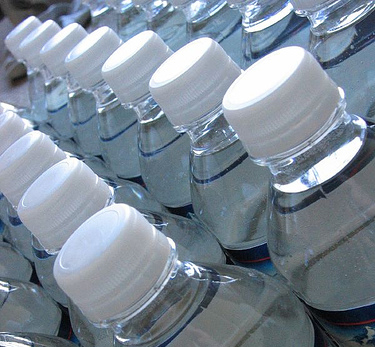
I’m giving up water for 30 days. Bottled water that is.
In the discussion of the carbon footprint of wine here last week, I floated the idea of purchasing carbon offsets to assuage carbon guilt. In case I had any doubt of the efficacy of this matter, an excellent column in the Financial Times last week on the subject of offsets made me put paid to this notion.
A hilarious quote compared the system of carbon offsets to “the medieval system of indulgences, in which corrupt priests absolved sins for haggled fees.” The author, John Guthrie, went on to say that the practice of buying tracts of forest land for protection as offsets may be out of favor now. The band Coldplay bought 10,000 mango trees in southern India to offset the carbon produced by the release of their second album. Five years later, the trees have now withered and died.
So if I am to make my wine drinking carbon neutral, I can’t buy my way out of it: I actually have to give something up. I figure I should go beverage-for-beverage, in other words, keep wine, and give up something else. I’d love to say that I would give up soda, but since I haven’t had a soda in something like 15 years, that would kind of be like my giving up snowmobiling, jet-skiing, and being driven to work in a stretch Hummer limousine (oh wait, that last one actually WILL be tough to give up).
Because the kind of wine that I enjoy is a unique product that can’t be replaced locally, I have another target in my sights that can: bottled water. It’s one of those paradoxes of the global era to be able to buy spring water from the French alps or the islands of Fiji in New York when there is abundant drinkable tap water available (unlike some countries, the efforts of a current UNICEF campaign). And, as a commenter pointed out in a previous posting, this chart shows that bottled water’s growth rate is faster than wine–it must be stopped!
So for 30 days I’m not going to consume any bottled water. Just what kind of a sacrifice will that be? Granted, not a huge one. I might save the world something like 30 bottles of water. But it’s a start. And I may even extend it if I can live without my favorite Gerolsteiner. So if you’ll excuse me, I have to go and fill up my water bottle at the drinking fountain.
(image)
The carbon footprint of wine
I recently tasted the intense, fruit-forward Tikal, Amorio, 2005 (about $30; find this wine). Along with notes of dark berries, tobacco and toast, was there also a whiff of petroleum?
The wine’s oversized bottle complemented the flavor profile perfectly since the bottle weighed about as much empty as a regular bottle full. I pity the wine store clerk who has to lift a case of it.
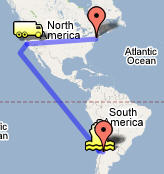 The heavy bottle took a long, meandering route to get to me in New York City. Starting out at the winery in Mendoza, Argentina, the wine’s American importer trucked it over the Andes to the port of San Antonio in Chile. There it loaded a boat and went to Oakland, CA. From there it came across country by truck to me in New York.
The heavy bottle took a long, meandering route to get to me in New York City. Starting out at the winery in Mendoza, Argentina, the wine’s American importer trucked it over the Andes to the port of San Antonio in Chile. There it loaded a boat and went to Oakland, CA. From there it came across country by truck to me in New York.
That’s a lot of carbon used to bring me this bottle of vino. But is it too much? At least the heavy bottle didn’t come by plane, which would have really jacked the petroleum per ounce of wine.
I was intrigued to read in the SF Chronicle that several restaurants have stopped serving (imported) bottled water because it is deemed too carbon inefficient.
Michael Pollan’s The Omnivore’s Dilemma prompted many eaters to think about the “carbon footprint” of their food and consider locally produced foods. Does that translate for you to your wine consumption?
The key issue for me is ease of substitution. I may be able to get water from local sources, but I can’t get any malbec locally. A tough call. Perhaps any eco guilt could be assuaged by buying carbon offsets?
Related:
“Local tap water bubbles up in restaurants” [SF Chronicle]
“Carbon neutral is hip, but is it green?” [NYT]
Questions on French wine tariffs!
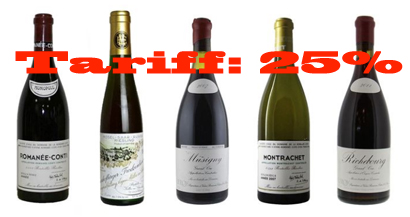
Our post about the 25% tariff that will be imposed on the $.2.5 billion of wines imported from France, Spain and Germany as of October 18 raised some questions. We respond:
Rick: How do you suppose this will affect futures orders that are in place?
Dr. Vino: They will be hit by the 25% levy if they arrive in the US after October 18. This could lead to the smart collector’s money either (A) diverting toward wines already in the US that are available at auction (they have the added bonus of being perhaps more ready to drink) or (B) perhaps the merchant that sold you the future is prepared to hold off on taking delivery until the tariffs are called off. This trade dispute can’t go on forever, right?!
Carol: Since Italian wines are not hit by tariffs, will this be a Prosecco New Year’s Eve?
Dr. Vino: Champagne somehow dodged the tariff bullet so your choice of bubbly will be tariff-free.
Carol, with a follow-up: So will wine prices be rising this holiday season?
Dr. Vino: It is unclear if there will be price hikes on store shelves (and restaurant wine lists as soon as December). Many shops or restaurants could conceivably buy now to insulate themselves and distributor warehouses are probably pretty full in anticipation of both year-end madness and perhaps this tariff move. One rep I spoke with said their distributor is not expecting price hikes for six months. But who knows–others may not be as well positioned and have to pass these tariffs on to consumers sooner.
Jade: Should I pre-buy my wine now for the rest of the year?
Dr. Vino: Sure! I never would tell you not to! There are so many great wines in the market right now plus a lot of stores offer discounts on 12+ bottles. And you know the holidays are coming…oh, and have you seen the news recently? Oh, man…might make you want to crack into your stash.
Juliette: so will French rosé next year be 25% more expensive?
Dr. Vino: If the issue remains unresolved and the tariffs are still in place, then yes. Any 2019 wine from these three countries would be impacted–even Beaujolais Nouveau!
Leslie: How exactly do the tariffs affect the auction market? If a past vintage passes from an affected EU country will that be subject to tariff? Do auction wines now become more valuable if they are unaffected by the tariffs?
Dr. Vino: Wines in the US before Oct 18 are not hit by tariffs. So, yes, there’s a chance that if futures buyers like Rick divert their funds to collectible wines that are slumbering in cellars across America now, then, yes, there could be a bump in the auction market for French (and German and Spanish) wines.
Okay, that’s all the questions for now. But I did want to reproduce the text of the directive on French wine tariffs (and Spanish and German and UK wine): “Wine other than Tokay (not carbonated), not over 14% alcohol, in containers not over two liters.”
So weird that wine over 14% alc gets a pass! so all Chateauneuf du Pape comes in unaffected? To Juliette’s point above, maybe we will see some 14% alc roses? 😛 Also, game on for double mags of French wine! And champagne!
Also, final fun fact: $16 million of wine was imported from the UK last year! I knew it was, uh, small beer, but that is actually more than I thought!
UPDATE: this post was edited to reflect the fact that champagne will not be affected by the tariffs. Neither will cognac or handbags so a big wine for LV to the MH.
Slinging juice: my side hustle at Parlor Pizza

My good friend, chef Tim Labant, and I have ridden probably 15,000 miles together on our bikes the past few years. We’ve had some epic adventures. Tim is the chef/owner of Schoolhouse at Cannondale, a new American spot in Wilton that celebrated its eleventh anniversary this past spring. About three years ago, Tim decided he wanted to bring his fine dining skills to a more casual environment. He loves pizza (who doesn’t?), so he started developing his own dough recipe. He went to Pizza Expo in Las Vegas two years in a row, refining his recipe and researching ovens. As the restaurant was developing, he asked me to put together the wine list and I was only too happy to help.
Everything came together about five weeks ago when Parlor opened its doors. Tim’s dough uses two types of Italian (Caputo) flour and has a multiday fermentation and proofing. The pies get baked in a Pavesi oven that’s fire-truck red. The dough has a chewy mouthfeel that makes you not even want to talk, just indulge in another bite until the pie is gone. The sautéed mushroom with taleggio is one of my favorites; the white clam sees fresh littlenecks steamed open, shucked and then placed on a creamy reduction sauce. The salads and sides are not to miss either.
To complement this simple but tasty menu, we put together a wine list that has something for everyone–but it may not be the exact something people thought they wanted when they came in. For example, a guest came in recently and asked for “a glass of chardonnay.” When I pointed out that we don’t have one by the glass (but we do have the excellent Sandhi chardonnay by the bottle), I suggested an erbaluce from Luigi Ferrando, the celebrated (for his reds, mostly) producer from Carema in the north of Piedmont. I poured her a taste; she liked it and ordered a glass. Then another. So that was my mini triumph of the night, turning a generic “chardonnay” drinker into a two-glass erbaluce enthusiast.
The list has a smattering of fun wines over $100 and a bunch of crystal decanters. But sensitive to the value needs of a pizza place, the list also has ten wines by the the bottle under $30 and ten wines by the glass starting at $8. We have three wines on keg too (lower carbon footprint!) that we serve by the quartino. We have wines from Italy, France, New York, California, Spain and Austria on the list right now. We have orange wine and pet nat. We will rotate wines in and out and have some special pours too. The wine world is a big and exciting place right now and we are happy to show off some tasty portions of it.
Stop by and check it all out! Connecticut is beautiful, especially this time of year.
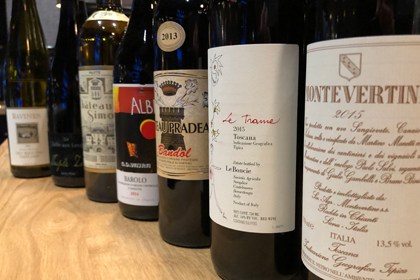 Read more…
Read more…
Sparkling water, acidity, wine and teeth
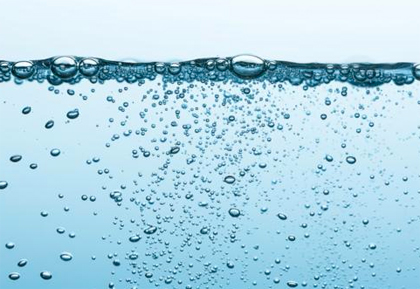
There was a scaaaary story circulating the internets recently: Sparkling water is not good for your teeth! Some variants of the story even compared it to soda! Eeegad–just when you thought you were doing the right thing by completely depriving yourself of any flavor…
Well, as with most scaaaaary headlines, there are some caveats. And these also will allay any fears about wine.
Sparkling water is a lower pH than regular water, which, as we all remember from chemistry class, should be 7.0 or neutral. Sparkling water is about 5.5. Why? Well, the bubbles come with carbonic acid, which reduces the pH (below 7.0 is more acidic). Is that catastrophically bad? No. But the author of the much-circulated piece admitted to drinking 144 ounces of seltzer water in a day, so, yeah, that perma-bath of acidity all day long could be a little destructive if repeated daily. (Btw, reverse osmosis water reduces the pH in its filtering process so if you carbonate RO water via a system such as Soda Stream, it will have an even lower pH than non-RO water.) Sodas can have a pH of 2.5 and have been shown to be many times more corrosive than sparkling water.
So what about wine? Well, even though wine has a lower pH than neutral water, it is not a beverage that most people drink 144 ounces of. If someone had a particularly good night at a dinner, a half a bottle is only 12 ounces of wine. Combine that with food for a “buffering effect,” and, yeah, not a big deal in the dental department.
But what can be harder is tasting a lot of low pH wines such as Riesling or Champagnes. These high-acid wines can have a pH of 2.8-3.3 range. Tastings of these wines can be harder on the teeth and gums than tastings with tannic red wines, which have their own side effects of teeth discoloration (A smile and “hi honey, I’m home” after one of these tastings is usually met with “red wine this time?”). One dentist suggested to me that brushing after a tasting would be better than before a tasting, which would remove build up that could protect the teeth.
Anyway, wine tasters can get some relief in the fact that Sensodyne toothpaste and a Philips Sonicare toothbrush is probably all you need at the end of the day to combat even the toughest Riesling tasting regimen. Regular dental checkups are also advised. 🙂
